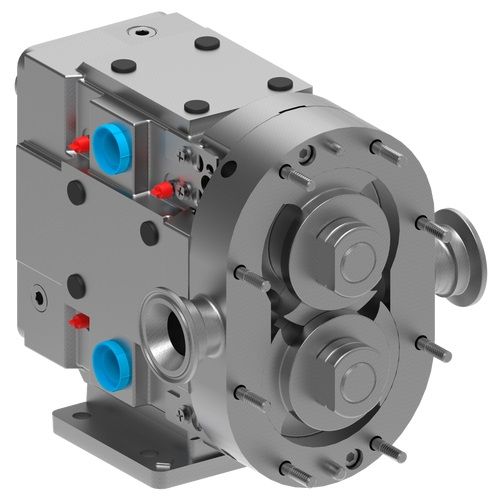We use cookies to help us deliver and improve this site. By clicking Confirm or by continuing to use the site, you agree to our use of cookies. For more information see our Cookie Policy.
Six Key Reasons to Convert to Hygienic Internal Gear Pumps
The Hydraulic Institute has classified more than 30 unique types of rotary Positive Displacement (PD) pumps, each providing different features and benefits. Fortunately for the food and beverage, pharmaceutical/biopharm and personal care product industries, many of these pumping principles are available in hygienic versions. Faced with these many choices, it’s up to each of us to find the right balance of performance, reliability, cleanability, maintenance, capital cost and operating cost to suit our own facility’s needs.
One pump technology that has recently become available in hygienic versions is the internal gear pump. It is a rotary PD pump, meaning that with every rotation of the shaft, the pump draws in and then displaces the same volume of liquid. That gives it some big benefits, including:
-
Easily adjustable flow rates using a variable speed drive, since the flow is directly proportional to the speed of the motor
-
Flow independent of changes in system pressure, enabling accurate metering into batches
-
Reversible direction of flow to strip the line of product, reducing waste and reducing water and chemical usage during CIP
-
Ability to handle a wide range of viscosities, from milk to peanut butter
-
Minimal product degradation due to shear, because shear forces are proportional to pump speed, and rotary PD pumps can be operated at very low speeds to minimize shear
-
Smooth flow and high efficiency (compared to reciprocating pumps, for example), which improves accuracy of flow meters and reduces splashing when discharging into tanks or packaging
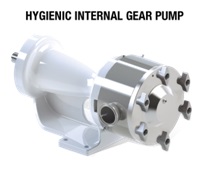
To illustrate the differences between internal gear pumps and other hygienic rotary PD pumps, we need to look at the technologies employed.
Timed Lobe and Circumferential Piston Pumps
The most widely used hygienic rotary PD technologies are the timed lobe and circumferential piston pumps. These utilize two pumping elements, each on its own shaft, and connected by a set of timing gears external to the pumped liquid. The driver shaft is connected to the motor, and the timing gears turn the driven shaft as the driver shaft rotates. The advantage is that the pumping elements (rotors) rarely touch, which allows use of soft materials like stainless steel that could gall (cold weld) on contact. The key disadvantages are that: 1) the timing gears are housed in an oil or grease-lubricated gearbox that requires frequent lube changes, 2) each shaft requires its own shaft seal (seal failure is the most common cause of pump downtime), and 3) setting the timing and end clearance during a rebuild can be a maintenance headache, usually requiring shims (assemble, measure, disassemble, shim, reassemble, measure, repeat), consuming precious time.
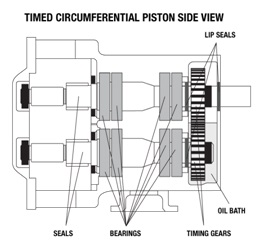
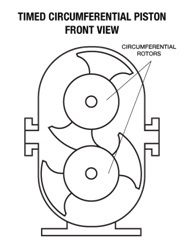
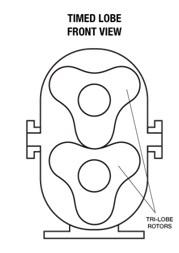
Timed Twin-Screw Pumps
Another timed-pump technology is the twin screw pump, which substitutes screws for rotors. A unique advantage is that they offer the ability to run at very high speeds on CIP solutions, often up to 3600 RPM, which develops sufficient velocity that a separate CIP pump may not be required. Normal operation is usually at much slower speeds to handle the product. The disadvantage is that to CIP you need a variable speed drive with a significantly higher horsepower motor to operate at high speeds than you would need for normal operation, which may be at only 10% or less of the CIP speed. Operating the VFD system at very low speeds to handle the product results in poor energy efficiency and shorter motor life. Operating the pump at very high speeds to CIP results in shorter seal and bearing life.
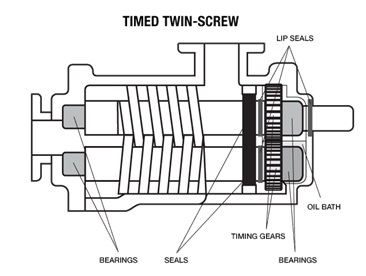
Progressive Cavity Pumps
Another popular technology is the progressive cavity pump, which has a single, helical-shaped rotor turning within an elastomeric stator, creating cavities that continually shift from the suction end to the discharge end. Advantages include only one shaft seal, the ability to gently handle abrasive slurries and large solids, and the ability to multi-stage to develop ever-higher pressures, if needed. Key disadvantages include 1) elastomeric particle shedding into the product when the pump is run dry, 2) high cost of stator replacement and 3) the difficulty of in-place disassembly for Clean Out of Place (COP) or post Clean in Place (CIP) inspection due to the extremely long footprint.
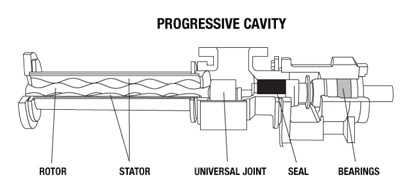
Peristaltic Pumps
Peristaltic, or hose pumps, feature an elastomeric hose that is compressed by rollers to create continuously moving fluid cavities. Key advantages include single use capability on smaller pumps for ultra-clean pharmaceutical and biopharmaceutical products, and ability to handle large solids with larger diameter hose pumps. Key disadvantages include 1) frequency and cost of hose and coolant replacement, commonly up to 7 times per year, 2) potential for cross-contamination of pumped product and coolant when the hose ruptures, and 3) no jacketing capability to melt ambient temperature solids like chocolate.
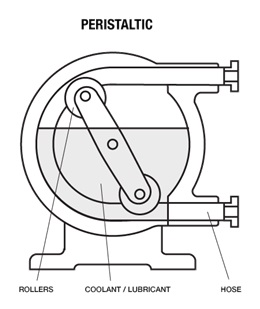
Internal Gear Pumps
An internal gear pump is one in which the rotor gear (connected to the driver shaft, which is connected to the motor), turns the driven gear (idler) in the pumped liquid, so no timing gears are needed. The idler gear rotates on a fixed shaft (idler pin) mounted to the pump head. The gears unmesh on the suction side and spaces between the gear teeth carry liquid from suction to discharge side, where the gears then mesh to expel the liquid. Advantages compared to timed pumps include only one shaft seal, no timing gears or lubrication, and ease of maintenance (no shimming). Advantages vs. PC and peristaltic pumps include short-term run dry capability without particle shedding, easy in-line or 90° porting, and ease of in-place disassembly for COP or post-CIP inspection. Disadvantages compared to both timed and PC/peristaltic pumps include inability to pass large solids (like whole fruits) and limited differential pressures (150 PSI / 10 bar).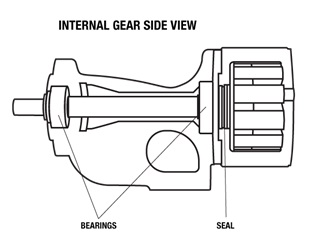
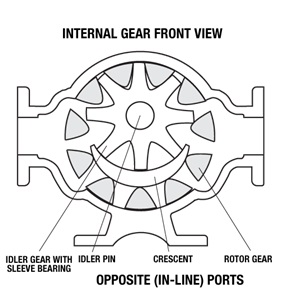
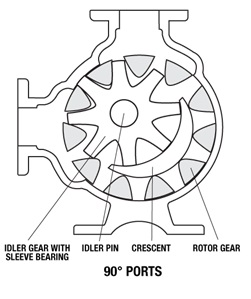
Internal Gear Benefits
The top six reasons, then, to consider hygienic internal gear pumps versus other types of rotary PD pumps include:
-
Only one shaft seal. It was demonstrated several years ago in a survey of pump repair shops that shaft seals, specifically mechanical seals, are the single largest cause of pump downtime and maintenance. If a pump has two seals instead of one, it essentially doubles the odds of failure, not to mention the cost of replacements. If a pump is cleaned-out-of-place, it also speeds up disassembly and reassembly time by a third compared to pumps with two seals. If you’re cleaning 10 pumps a day, that adds up.
-
90° or in-line mounting. The choice is yours. No other hygienic pump offers the option of 90° ports for mounting directly under tanks, or opposite ports for simple in-line mounting. That means you can insert a pump anywhere along a length of straight pipe. Opposite port pumps also give you the capability of vertical orientation, which allows complete self-draining prior to cleaning, and is required for EHEDG certification.
-
No oil to change. Internal gear pumps use sealed antifriction bearings with food grade grease and require no re-lubrication. Pumps with timing gears and bearings in a lubricated gearbox usually require oil or grease changes at least four times per year, or more in humid, washdown environments. It is said that one drop of water in a quart of oil will destroy its lubricating properties, and these gearboxes allow humid air into the gearbox through the breather or oil seal as it cools down, causing internal condensation and lube failure.
-
Same pump for COP or CIP. Designed for ease of disassembly and reassembly in-place, internal gear pumps feature front-removable rotor and idler, shaft seal and casing for COP. Yet the same pump can be configured to be completely CIP-able. Pumps with EHEDG certification for in-place cleanability have been rigorously tested and validated for in-place cleanability. For processors which COP today, but are considering CIP in the future, this means they can use the same pump for either, while many other pumps require factory modifications for CIP, if they can be made CIP-able at all.
-
Fast, easy end clearance adjustment – no shimming. Clearances are adjusted on rotary PD pumps to optimize the performance based on the viscosity, to prevent rotor/casing contact due to expansion from high temperatures, and to compensate for wear over time. Internal gear pumps enable easy end clearance adjustment by rotating the threaded rear bearing housing. Rotate it clockwise until the rotor contacts the head, then back it off counter-clockwise a set distance per 0.001” of clearance required, and lock it down with set screws. This takes about five minutes. Timed pumps must be timed to ensure that their pumping elements never actually contact each other, often using shims, which are also used to set end clearances. This process usually takes several hours, in which a pump is assembled, measured, disassembled, shimmed, reassembled, measured, and sometimes that process has to be repeated to get it just right.
-
Dimensionally interchangeable with existing gear pumps. There is a large installed base of internal gear pumps from several manufacturers handling low hazard foods like edible oils and personal care intermediates that comply to an unofficial dimensional standard set long ago by the market leader. Hygienic internal gear pumps also fit that standard, and are available with ANSI-compatible flange ports to drop into these low hazard applications, or with hygienic ports for higher hazard liquids like dairy. As hygiene requirements become more stringent, replacement of “industrial” pumps with hygienic pumps will be commonplace on even low hazard oils and chocolates.
In conclusion, it’s up to each facility to match the right pump to the job. Internal gear pumps are not for everything, but they do excel in many applications including edible oils, chocolate and peanut butter; sugars, sweeteners and confectionary; jams and jellies, sauces and pastes. In the pharma and personal care world, they are especially well suited to syrups and ointments, lotions and creams, and hair care products, to name a few.
Timed lobe, circumferential piston and twin-screw pumps are excellent performers, but their overly complicated design is overkill if you are not pumping large solids or if you don’t need differential pressures exceeding 150 PSI (10 bar). Consider a simpler solution, internal gear pumps, for those easy applications. Similarly, progressive cavity or peristaltic pumps may be a great choice for slurries of whole berries, but for strawberry jelly or jam, an internal gear pump offers significant benefits in terms of higher reliability and reduced maintenance.
Additional information resources on all types of rotary displacement pumps, hygienic or not, is available here.
Click here for more information on Viking Pump Hygienic Series internal gear pumps.
Author: John H. Hall, Senior Product Manager, Viking Pump Inc. ©2014

